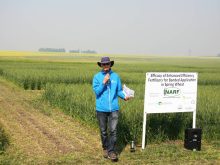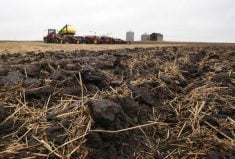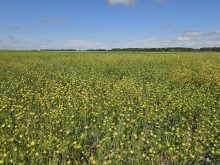SPRINGFIELD, Ill. — U.S. crop advisers are field scouting with remote control helicopters that could be straight out of the movies.
“The AutoCopter G15 is a gas powered remote control helicopter on steroids,” AutoCopter president Don Effren told the InfoAg precision farming conference in Springfield July 12.
He said the operator can stop on a dime if he sees something of concern on the monitor. The infrared system detects crop disease, plant nutrition deficiencies and other problems that might affect yields.
Read Also

Rising vegetable oil demand may offset bad biofuel news
Global biodiesel/renewable diesel production is expected to decline for the first time in a decade. Bad timing for a canola industry looking for new markets.
“You hover down for a closer look, take some photos, then hit the resume button and go back up to continue your flight pattern without losing your GPS position,” he said.
“Every time you go down for a close-up, the images are automatically geo-referenced with metadata that includes elevation, precise longitude and latitude or anything else you may request.”
AutoCopter has a German-built airframe, GPS referenced autopilot, automatic takeoff and landing capabilities and a working radius of almost 10 kilometres from the operator.
It saves the flight patterns so the exact same pattern can be repeated over again in subsequent years.
It runs high definition video and a multi-spectra camera for NDVI imaging. The raw data can be processed into NDVI maps in the field within 10 minutes.
Effren said the solid-state gyro system creates a more stable platform for higher quality aerial photos. Movie producers have begun buying the G15 for aerial shots rather than rent a full size helicopter.
He said farmers who practise precision agriculture also benefit from the stable platform because they get crisper images.
“One of the biggest advantages over fixed wing remote control airplanes is we don’t have crash landings,” he said.
“There’s no hand launching or trying to find a soft spot in the crop for landing. AutoCopter can take off and land from the roof of your pickup. It’s all very gentle.”
However, he conceded that helicopters require more energy to remain airborne than do fixed wing aircraft. Airplanes have wings to carry the load, while helicopters need to keep their rotors spinning to generate lift.
A battery pack that keeps a remote controlled airplane up for more than an hour lasts only 10 minutes in a helicopter. As a result, the G15 is powered by a 23 cc two-cycle engine from a Yamaha weed whacker. A tank of mixed gas keeps the chopper flying for an hour.
The G15 weighs 15 pounds and is capable of carrying 15 lb. The carbon fibre rotors have a 71 inch span.
It can cruise at a height of 1 1/2 metres to several hundred metres.
The G15 AutoCopter sells for $50,000 to $75,000, depending on options.
For more information, contact Don Effren at 704-562-8469 or visit www.autocopter.net .















